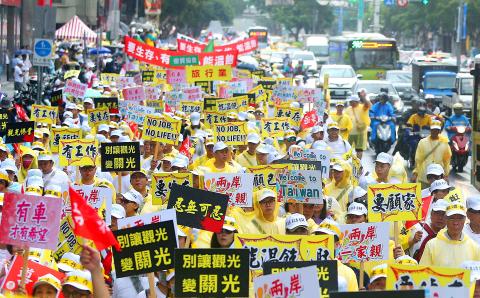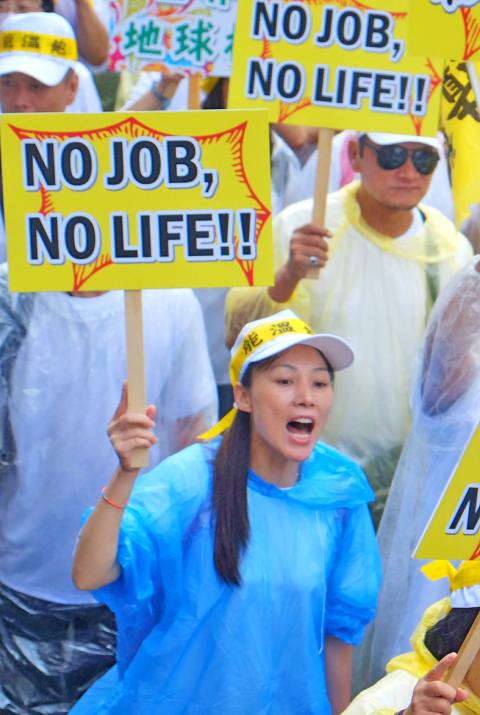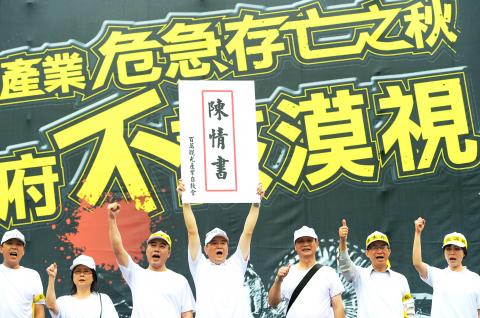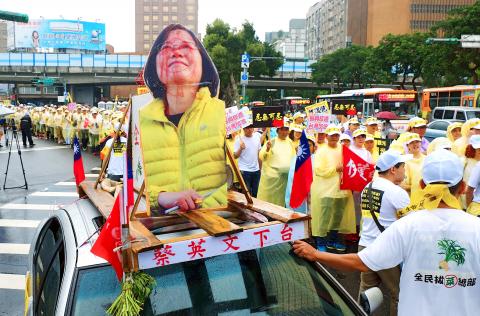About 10,000 people marched through downtown Taipei yesterday afternoon calling on the government to help the tourism industry amid a drop in the number of Chinese tourists.
It was the first-ever protest organized by people and firms in the tourism industry, including travel agencies, tour guides, hoteliers, hostel operators, restaurant owners, tour bus companies and representatives of other businesses.
The march began at the Huashan 1914 Creative Park and headed toward Ketagalan Boulevard by way of Chungshiao E Road, Hanzhou S Road and Renai Road.

Photo: CNA
A travel agency manager from Kaohsiung surnamed Rong (容) said those who took part in yesterday’s protest were “only the tip of an iceberg,” adding that the situation was expected to worsen in the next three months.
“We want to tell the government that its new southbound policy is not going to be an immediate cure to the travel industry’s current plight,” she said.
Tourism operators from southern Taiwan chartered at least 30 buses to bring people to Taipei, Rong said, adding that Chiayi County has been the hardest hit by the drop in Chinese visitor numbers.

Photo: Sam Yeh, AFP
Asked how bad the situation is, Rong said that some guides and bus drivers have been on unpaid furloughs for almost two months because there was no business from Chinese tour groups.
Alishan, a must-see destination for most of the Chinese tourists, now gets fewer than 10 tour buses per day, she said.
Boat owners at Sun Moon Lake (日月潭) are also hurting.

Photo: Chang Chia-ming, Taipei Times
“A tour guide used to be able to handle three tour groups every month, earning a monthly salary of between NT$50,000 and NT$100,000 [US$1,577 and US$3,153], but now they cannot do that anymore and they still have dozens of bills to pay. You can understand their anger and anxiety,” she said.
The NT$30 billion relief fund that the government is planning to spend to help the industry cannot possibly cover all the industry’s losses, she said.
A guide surnamed Lin (林) said that China’s National Day holiday is coming soon, and Japan and South Korea are trying to attract more tourists from China during that period.

Photo: Sam Yeh, AFP
Only Taiwan is trying to push Chinese tourists away, he said, adding: “I really do not know what our government is thinking.”
Lin said he is willing to follow the government’s policy to attract more tourists from Southeast Asia, but it must provide complementary measures to help address the problems businesses are facing.
He said he has a mortgage of about NT$10 million and has not had any income for two months, while his friends who own tour buses are struggling to pay off the loans they took out to buy the vehicles.
A luxury goods store representative from Hualien, who spoke on condition of anonymity, said the NT$30 billion is just a short-term solution.
“We want a fishing rod, not the government just providing us with fish,” she said.
Yesterday’s protest concluded with representatives of the travel industry delivering a petition to the Presidential Office.
The petition said that Taiwan attracted about 2 million Chinese tourists in tour groups last year, and the industry hoped about 1 million Chinese would come on group tours this year, representatives said.
However, that means the government needs to attract about 2 million more travelers from other countries to make up for the shortfall in Chinese tourists because Chinese spend about twice as much time in Taiwan as travelers from other countries, they said.
To make up such a huge shortfall, 12 suggestions were made, ranging from further streamlining visa application procedures for Southeast Asian tourists, allowing Chinese tourists to use their passports for a 72-hour transit in Taiwan before heading to a third country, offering subsidies to international tourists who spend at least two nights in central or southern Taiwan and raising the number of domestic travelers nationwide by giving out vouchers for weekday travel.

The US government has signed defense cooperation agreements with Japan and the Philippines to boost the deterrence capabilities of countries in the first island chain, a report by the National Security Bureau (NSB) showed. The main countries on the first island chain include the two nations and Taiwan. The bureau is to present the report at a meeting of the legislature’s Foreign Affairs and National Defense Committee tomorrow. The US military has deployed Typhon missile systems to Japan’s Yamaguchi Prefecture and Zambales province in the Philippines during their joint military exercises. It has also installed NMESIS anti-ship systems in Japan’s Okinawa

‘WIN-WIN’: The Philippines, and central and eastern European countries are important potential drone cooperation partners, Minister of Foreign Affairs Lin Chia-lung said Minister of Foreign Affairs Lin Chia-lung (林佳龍) in an interview published yesterday confirmed that there are joint ventures between Taiwan and Poland in the drone industry. Lin made the remark in an exclusive interview with the Chinese-language Liberty Times (the Taipei Times’ sister paper). The government-backed Taiwan Excellence Drone International Business Opportunities Alliance and the Polish Chamber of Unmanned Systems on Wednesday last week signed a memorandum of understanding in Poland to develop a “non-China” supply chain for drones and work together on key technologies. Asked if Taiwan prioritized Poland among central and eastern European countries in drone collaboration, Lin

TRAGEDY STRIKES TAIPEI: The suspect died after falling off a building after he threw smoke grenades into Taipei Main Station and went on a killing spree in Zhongshan A 27-year-old suspect allegedly threw smoke grenades in Taipei Main Station and then proceeded to Zhongshan MRT Station in a random killing spree that resulted in the death of the suspect and two other civilians, and seven injured, including one in critical condition, as of press time last night. The suspect, identified as a man surnamed Chang Wen (張文), allegedly began the attack at Taipei Main Station, the Taipei Fire Department said, adding that it received a report at 5:24pm that smoke grenades had been thrown in the station. One man in his 50s was rushed to hospital after a cardiac arrest

ON ALERT: Taiwan’s partners would issue warnings if China attempted to use Interpol to target Taiwanese, and the global body has mechanisms to prevent it, an official said China has stationed two to four people specializing in Taiwan affairs at its embassies in several democratic countries to monitor and harass Taiwanese, actions that the host nations would not tolerate, National Security Bureau (NSB) Director-General Tsai Ming-yen (蔡明彥) said yesterday. Tsai made the comments at a meeting of the legislature’s Foreign Affairs and National Defense Committee, which asked him and Minister of National Defense Wellington Koo (顧立雄) to report on potential conflicts in the Taiwan Strait and military preparedness. Democratic Progressive Party (DPP) Legislator Michelle Lin (林楚茵) expressed concern that Beijing has posted personnel from China’s Taiwan Affairs Office to its